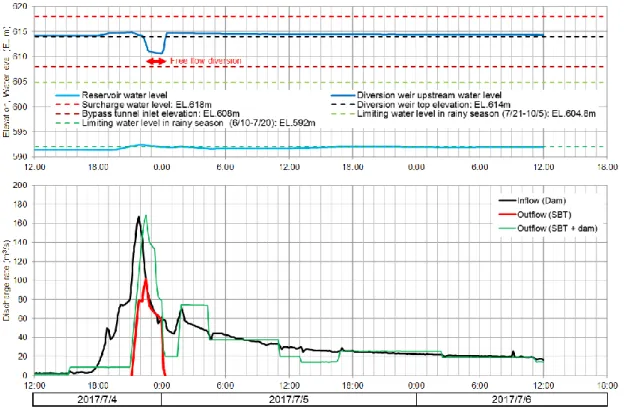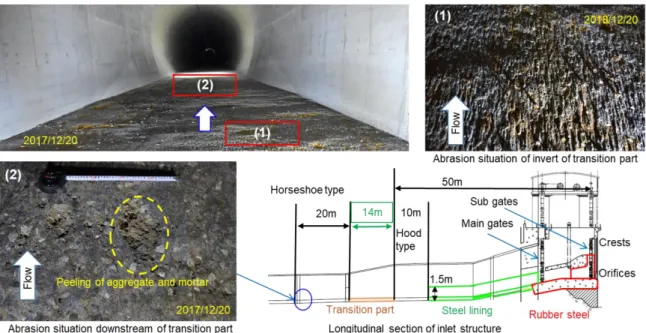Operation Results of the Koshibu Dam
Sediment Bypass Tunnel Completed in 2016
Katsushi Ishida, Toshiyuki Sakurai and Tetsuya Sumi
Abstract
The Koshibu Dam was constructed in 1969 and managed by the Ministry of Land, Infrastructure, Transport and Tourism, Japan. At the Koshibu Dam, the sediment bypass tunnel (SBT) project was launched in 2000 with the aim of preventing sedimentation in the reservoir and ensuring the continuity of sediment transport at the river. The SBT was completed in September 2016.
After completion of the SBT, we carried out a total of eight bypass discharges, twice in 2016, three times in 2017 and three times in 2018. In this paper, we mainly report on monitoring results of discharges in 2017.
In 2017, we discharged a maximum discharge rate of 183 m3/s. This discharge rate is about 50% of the planned maximum discharge rate of the SBT 370 m3/s and equivalent to the average annual maximum discharge rate scale. As a result of monitoring, it was confirmed that there was no problem in gate operation, no significant abrasion damages in the facility and no significant environmental change in the downstream river. It was estimated that about 34,000 m3 of sediment was bypassed to the dam downstream by
three times operations in 2017. We could take the bypassed sediment grain size distribution and the sediment transport characteristics during bypass operations.
Based on the lessons in 2017, we will try to improve the SBT operation by more precise analysis on the relationship among inflow discharge rate, gate operation and sediment inflow to the tunnel. Monitoring results on bypassed sediment budget and grain size, abrasion damage on the tunnel invert as well as changes in downstream riverbed morphology and aquatic communities will be also studied to feedback to the operation. Keywords: Sediment bypass tunnel, gate operation, monitoring, sediment budget, abrasion damage
1 Outline of the Koshibu dam and its SBT facilities
The Koshibu Dam is an arch type concrete dam of 105 meters high for flood control, irrigation and power generation constructed in 1969. Figure 1 shows the outline of the Koshibu dam and its SBT facilities. Regarding the background and history of the project, specifications and structure of the facilities of the Koshibu Dam and its SBT, please refer to the past reports (Kashiwai, J., Kimura, S. (2015), Takeuchi et al. (2017), Sakurai et al. (2018)).
Figure 1: The outline of the Koshibu dam and its SBT facilities
2 The trial SBT operation method and monitoring method in 2017
In order to understand the change of sediment transport dynamics and river environment and to decide the formal operation method of SBT, trial operation of the SBT and monitoring has been carried out. Specific operational rules during the trial period and monitoring method for sediment budget are discribed below.2.1 The trial SBT operation method
The policy of the trial SBT operation method as of 2017 was to discharge as much as possible from the SBT during flood to the extent that it does not affect the water use capacity of the reservoir. Specifically, when the inflow dsicharge rate during flood exceeds 60 m3/s, the gate of SBT is opened and discharge is started. After that, discharge from the SBT as much as possible within the range of discharge amount in the flood control rule of Koshibu Dam. When the inflow discharge rate decreases below 60 m3/s, the gate of SBT is closed and the discharge from SBT is finished. Regarding this
trial operation method, the formal operation method will be examined reflecting the monitoring results of future trial SBT operations.
2.2 Sediment budget monitoring method
In order to understand the sediment budget in the SBT operation during flood, it is necessary to confirm the sediment quantity by each grain size with regard to "Dam inflow", "Bypass outflow" and "Dam outflow".
The budget of the gravel is estimated from the riverbed survey upstream and downstream of the bypass tunnel, before and after floods, and from the riverbed material investigation. Survey will be also conducted after the flood season. Since it is necessary to get data in more detail at the diversion pool and the energy dissipator, precise surveys will be conducted before and after the bypass operation. In addition, as the first case of the SBT in Japan, sediment observation devices (plate type sensor etc., Sakurai et al. (2017), Koshiba, T., Sumi, T. (2017), Koshiba et al. (2017)) were installed on the bottom of the tunnel outlet part.
With regard to the sand, it is difficult to observe all amount of the sand transport during flood. Therefore, using the observed data as a verification data, the amount of the sand transport is estimated from the plane two-dimensional river bed variation model analysis. For water sampling at the tunnel outlet, water intake pipes were installed on the training wall surface, in order to collect the discharged water at different water depths.
The amount of the silt transport is estimated by combining the discharge rate data with the suspended sediment concentration and the grain size distribution obtained by water sampling at the tunnel upstream and downstream points.
3 Trial operations and monitoring results in 2017
After completion of the Koshibu dam SBT, trial discharge of the SBT during flood was carried out 8 times by September 2018. It was conducted twice during the floods caused by the typhoon and the front line in 2016, three times during the floods caused by the typhoon in 2017, three times during the floods caused by the typhoon in 2018. The trial discharge conducted in September, 2018 was the maximum discharge rate and the longest time discharge so far. The maximum discharge rate of the SBT was 195 m3/s (about 50% of the design maximum discharge rate of 370 m3/s), and the discharge time was about 69 hours. In this report, we describe about the trial discharges in 2017 when the monitoring data arrangement has been completed.
3.1 Trial operations in 2017
Hydorographs of three trial operations in 2017 are shown in Figure 2 to 4. And Figure 5 shows photographs of flow conditions in the inlet and outlet part of the SBT during the third trial operation.
Figure 2: Hydrographs of the first trial operation in 2017
Figure 4: Hydrographs of the third trial operation in 2017
Figure 5: Flow conditions of the SBT inlet (left) and outlet (right) at third trial operation in 2017 (2017/10/29 17:00, SBT discharge rate: about 50 m3/s)
In the first operation, the maximum discharge rate from the SBT was about 100 m3/s. At the time when the inflow dishcarge rate became 60 m3/s (SBT operation finish judgment
reference dishcarge rate), the SBT discharge was terminated and it was a short-term discharge of about 3 hours.
In the second operation, the largest past SBT discharge rate at the time 183 m3/s was dishcarged. The discharge time was about 10 hours, and after the peak of the inflow, the
inflow discharge rate was 60 m3/s or more, but the SBT discharge was terminated in order to recover the water use capacity.
In the third operation, since the water use capacity was kept at the beginning of the flood, when the inflow amount was less than 60 m3/s, the SBT discharge was started earlier. Although the maximum SBT discharge rate was not so much as 86 m3/s, about 49 hours of discharge, which is the longest at the time, was carried out.
3.2 Results of monitoring in 2017
As a result of trial operation of SBT in 2017, regarding structual aspects, wear of the surface mortar part was observed over the entire bypass tunnel and aggregate exposure was confirmed at a part of invert concrete, but there was no serious damage (Figure 6). And there was no major damage to near the inlet part protected by the steel lining and rubber steel. There was no accumulation of sediment or driftwood in the tunnel.
Moreover, regarding SBT gate operation, it was confirmed that the gate could be reliably closed without sediment or driftwood being clogged.
As for the riverbed environment, the sediment supplied to the downstream by the SBT discharge reached the Tenryu River (main river) junction, and the increase of the sand and gravel was confirmed in the river bed downstream of the Koshibu dam.
Regarding the biological environments, major changes in attached algae, benthic organisms, fish and rare land plants have not been confirmed at the time of monitoring in 2017 due to SBT discharge.
4 Results of sediment budget monitoring in 2017
As a result of examination by combining survey results before and after trial operations, riverbed material investigation, water sampling analysis during trial operations and river bed variation model analysis, the sediment volume passed through the SBT in three trial operations in 2017 was estimated about 34,000 m3.
The sediment budget for each sediment grain size group is shown in Figure 7 together with annual average sediment budget plan of the Koshibu dam SBT. During the trial operations, about 67,000 m3 of sediment flowed from the upstream, about 15,000 m3 of sediment accumulated in the diversion pool and about 34,000 m3 of sediment was
bypassed. The propotion of sand in the bypassed sediment was as large as 70%. In addition, in the operations, the amount of reservoir sedimentation was suppressed to about 5,000 m3, and about 31,000 m3 of sediment was supplied to the downstream river. Compared with the annual average sediment bugdet plan (the left in Figure 7), since the flood frequency was smaller than usual and the scale of flood eventsr were small in 2017, the annual estimated inflow sediment volume about 150,000 m3 was quantitatively small. Although the ratio of bypassed sediment and inflow sediment of trial operations in 2017 was about 50%, which was close to the planned ratio.
Figure 7: The sediment budget for each sediment grain size group (left: annual average sediment budget plan of the Koshibu dam SBT, right: sediment budget during the trial operations in 2017)
5 Conclusions
The Koshibu dam SBT has been completed in 2016, and several trial discharges have been carried out so far. Although it was a relatively short time, the SBT discharged 183 m3/s, which is about 50% as compared with the planned maximum discharge rate of 370 m3/s in 2017. It is close to the average annual maximum outflow discharge scale.
As a result of monitoring, it was confirmed that there was no problem in gate operation, the facilities had no noticeable abrasion and damage, and no significant environmental change was confirmed. Moreover, it was able to understand approximaterly the sediment budget and the characteristics of sediment transport through the SBT.
In the future, we will continue monitoring, accumulate monitoring results of SBT discharge in various flood events, make an effort to understand the damage situation of the facilities, the change of river environment and sediment budget. We will try to improve the SBT operation by reflecting the monitoring results.
References
Takeuchi et al. (2017). Monitoring scheme for sediment bypass tunnel at the Koshibu Dam. 2nd International Workshop on Sediment Bypass Tunnels, Kyoto Japan.
Kashiwai, J., Kimura, S. (2015). Hydraulic examination of the Koshibu dam’s intake facilities for sediment bypass. Proc. First International Workshop on Sediment Bypass Tunnels, VAW-Mitteilungen 232, Laboratory of Hydraulics, Hydrology and Glaciology (VAW), ETH Zurich Switzerland, 45-54.
Sakurai et al. (2017). Bedload monitoring with impact plates at Koshibu sediment bypass tunnel. 2nd International Workshop on Sediment Bypass Tunnels, Kyoto Japan.
Koshiba, T., Sumi, T. (2017). Experimental study on measurement method of gravel discharge rate in highspeed flow using plate-type sensor. 2nd International Workshop on Sediment Bypass Tunnels, Kyoto Japan.
Koshiba et al. (2017). Field experiment of bedload transport rate measurement at sediment bypass tunnel. 85th Annual Meeting of ICOLD, Prague, Czech Republicio.
Authors (Text style: Authors Address)
Katsushi IshidaTenryu River Integrated Dam Management Office, Chubu Regional Development Bureau, Ministry of Land, Infrastructure, Transport and Tourism, Japan
Toshiyuki Sakurai (corresponding Author) Japan Dam Engineering Center, Japan Email: sakurai@jdec.or.jp
Tetsuya Sumi




